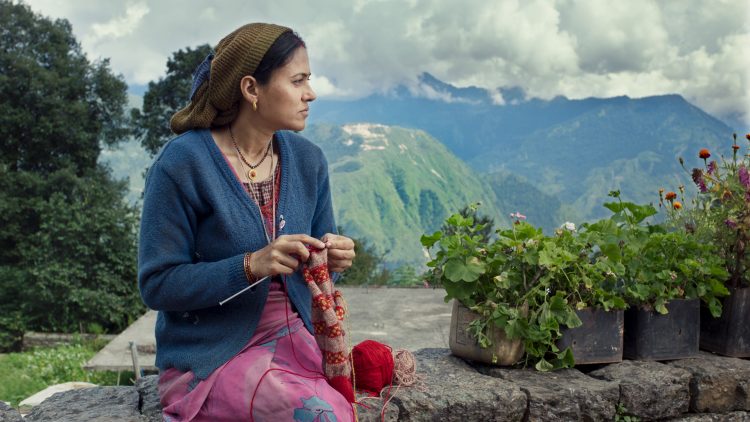There’s often a disconnect that comes with films that seek to present the lives of the poor. The politics of filmmaking – especially in the western world – are, so often, linked to the exigencies of capitalism that the two ideas do not often seem to mesh. It makes sense, then, that oftentimes the most thoughtful encounters with class and poverty occur outside of the West. Indian drama “Fire in the Mountains” offers itself as a welcome outlier among cinematic representations of the poor on screen. There is not a single moment of falsity in Ajitpal Singh’s feature-film debut. Instead, for every minute of its brief 80-minute running-time, the film aches with sadness and empathy as it considers the lives of those very often excluded from cinema.
The mountains in the film are both aesthetic and utilitarian, setting as well as symbol. In an opening sequence we see a woman, Chandra, running across a bridge in the mountains. The locale seems idyllic – the blueness of the sky, the greenness of the surrounding region, the pastoral beauty of the area. But Chandra has larger concerns than the picaresque landscape. She is in a hurry to make a living. In the opening scene Chandra, and a neighbour, compete for the attention of some visiting tourists. Both want the tourists in their Airbnb, and so they haggle – each lowering their prices until the profits are minimal. Chandra wins, but the success feels like a loss from the onset. As she struggles to carry their luggage up the trail, while they stop to take pictures, the moment sets us up for the cultural critique to come. The news on the radio pointing out India’s rise as a superpower is intentional, sly and ironic. Superpower, may be, but not for Chandra and her family.
Her homestay offers visitors a chance to enjoy a rustic slice of rural India, but for Chandra and her family the rustic existence is hardly idyllic even if the slyly titled name of the Airbnb (a slyly misspelled ‘Swizerland’) grasps at the idea of something more glamorous. Chandra, her husband and their son and daughter live on the side of the mountain. There is no proper road leading to or from their home, or their hotel, and the calamitous nature of the lack of road is made worse by the fact that her young son cannot walk. He has not attended school in half a year, and Chandra – the breadwinner in the family although ostensibly the hotel is run by the couple – must fetch him on her back down the mountain. We are not sure what ails him. The physiotherapist keeps recommending more tests.

Chandra fervently hopes for the best, but her husband resents the expense. He is certain that the family is cursed and that performing a Jagar ritual (a way of asking favours of ancestor spirits and deities in Folk Hinduism) will solve the trouble. Chandra is unconvinced. Her husband stews in anger. From her indomitable commitment to her son, her dogged saving of money for more tests, and her unwillingness to be cowed by him Dharan’s resentment of his wife builds to a crescendo of debilitating tragedies that we see coming long before they do. The foreshadowing is overwhelming and necessary to what Singh is up to here.
That this domestic strife is playing out amidst this particular locale of a potential tourist destination in a part of India where the ‘progress’ of globalised neoliberalism has failed to improve lives is specific and intentional. After the opening scene we rarely spend any time with the tourists, but it is key that the film sets their existence up as a structural necessity to the lives of these people. By frontloading that dependence, Singh sharply turns a potential familiar tale of domestic disturbances into a potent postcolonial critique that engages with issues of gender and class and this is where his unwillingness to steep this story in notions of false catharsis is sharp and profound.
Stylistically the film feels caught somewhere between an expressionistic focus on emotions and a naturalistic recognition of the way our surroundings affect our fate. Even as Singh’s work hews close to Chandra’s perspective, this is no story of a martyrdom or a facile tale of a perfect woman. How lucky for Singh that in Vinamrata Rai he has found a peerless vessel for the complex Chandra. Her performance is a tough and rewarding one. Her Chandra is both tough and persistent but also angry and petty and resentful. That resentment is key as her recognition of Chandra’s harshness makes her all the more empathetic. Whether it is frustration at her fate, guilt and disappointment at her TikTok obsessed daughter, exhaustion at her son’s weak spirit or bafflement at her husband, this is a woman who feels the full gamut of emotion.
“Fire in the Mountains” demonstrates a striking awareness of people not as symbols or as means to an end, but as complicated and sometimes paradoxical figures. It has no interest in providing artificial answers or making grand statements to wrap up its issues. Instead, Singh seeks to offer a glimpse into the class dynamics of people that are historically unconsidered. When Spivak was considering the dilemma of representing the voices of the oppressed in “Can the Subaltern Speak?” she was asking valuable questions about the ways that we present and consider the lives of the poor. Singh’s work is part of a necessary dialogue in World Cinema, and Indian cinema specifically, that seeks to engage with that liminality. It’s a striking work of searing emotional heft turning domestic drama into cultural critique.
Fire in the Mountains premiered at Sundance Film Festival in the World Cinema Dramatic category.


